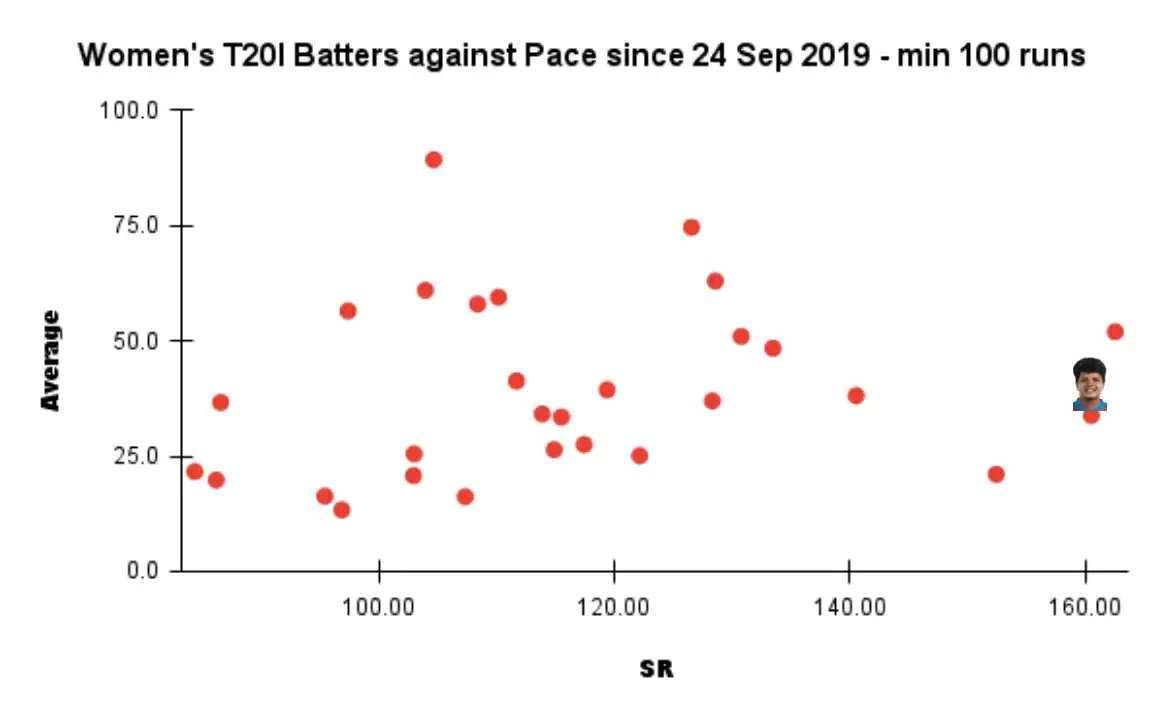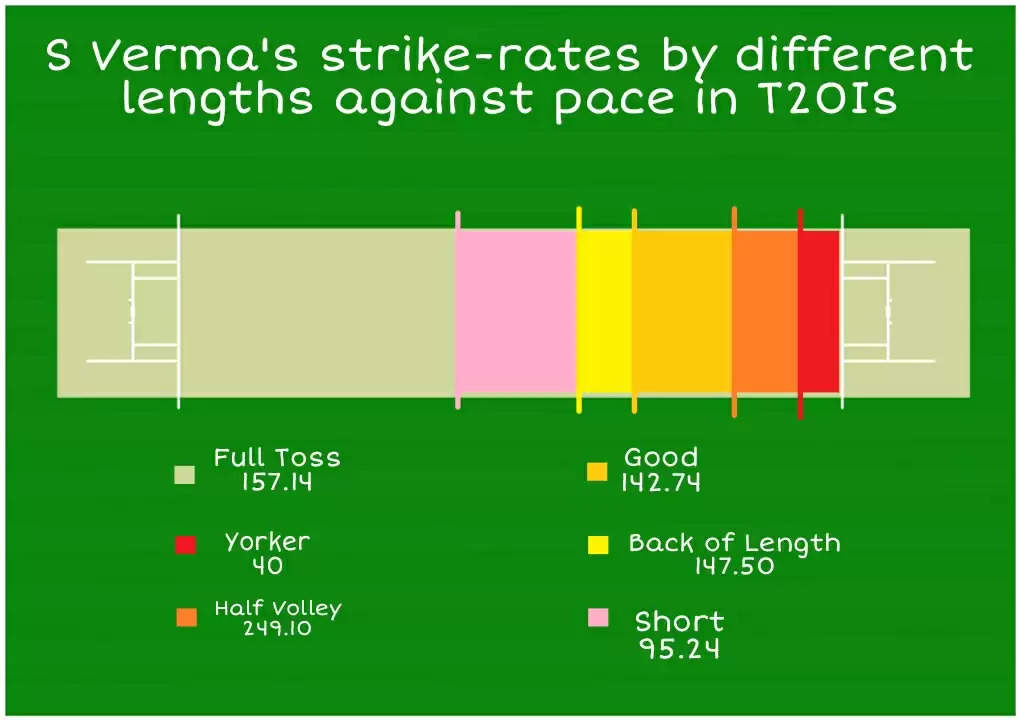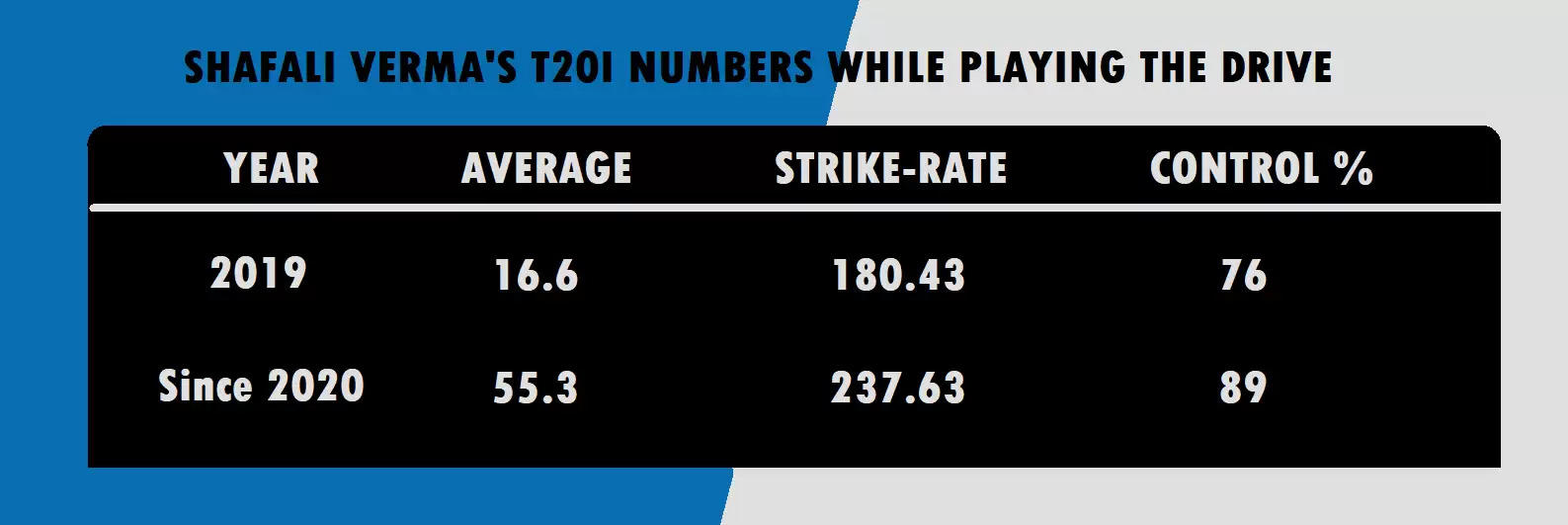Deep dive: What makes Shafali Verma so successful?

On 26 September 2017, ICC announced a slew of changes to the playing conditions in both the men’s and women’s game. One of those rule changes is the reduction of fielders outside the circle in non-Powerplay overs from five to four in women’s LOIs. This rule change allowed batters to approach the non-Powerplay overs in an attacking manner resulting in increased scoring rates. The average run rate in women’s T20Is before the rule change was 5.84 but it has risen to 6.41(excluded the teams which hadn’t played an official T20I before the rule change) after the rule change. It forced teams to search for powerful, fearless batters who can help them cope with the rising scoring rates.
On 7 March 2019 after a 2-0 loss against England Women in a bilateral T20I series in 2019, India’s stand-in T20I captain Smriti Mandhana urged domestic batters to step up and play fearless cricket to bridge the gap between domestic and international levels. Six months later, Shafali Verma debuted for India and displayed the same fearless attitude that her opening partner requested.

Shafali Verma needs no introduction. Ever since her debut at the young age of 15, she has grown both in stature and as a batter. She was the X-factor for India in the 2020 ICC Women’s T20WC and a chief contributor to their unbeaten run in the league stages. She’s currently the No.1 ranked WT20I player in the world and the second-highest run-scorer since her debut scoring 617 runs at a world-class strike rate of 148.32, hitting the most number of sixes during this period. An aggressive player with an attacking shot percentage of 63%, how’s she dominating such a fickle format so early in her career?
ALSO READ: Where are West Indies’ Test batters lagging?
The Pace Monster
Shafali’s batting numbers against pace in Women’s T20I’s read as 406 runs at an average of 33.8. No one has scored as much against pace since her debut, and her strike rate of 160.47 is only bettered by Fargana Hoque’s 162.5 (minimum 100 runs). A predominant front-foot player, she likes to take on the pace bowlers and she hits a boundary every 3.5 balls against them scoring 78.8% of her runs through boundaries.

Drives play a significant part in her success against pace as she has scored almost half of her runs against pace (49%) through this shot playing it once every 3.2 balls. Her strike rate for this shot type is a staggering 255 while averaging 40 runs per dismissal. Her drives weren’t this effective when she broke into the scene, and it required some technical changes to attain mastery over this shot. What are the technical changes she made to become more effective while playing the drives?
The Technical changes
Shafali Verma is a bottom-hand dominant batter and her trigger movement in her early days used to take her back leg across towards middle-stump with her front-leg landing on off-stump. It hindered her bat flow and made her head fall towards the offside at times while playing the deliveries that were bowled straight and her over-reliance on the bottom hand affected her control while playing the drives. These are well reflected in her control percentages while playing this shot, both against pace and spin. While these were some minor issues with this technique, the major issue was the short ball which we shall discuss later.

In the 2020 WT20I Tri-Series in Australia, Shafali Verma adopted a new trigger movement. While she still loaded the back leg by moving it back, the front leg either stayed afloat or placed beside the back leg instead of it landing ahead of the back leg as before. It provided her access to the straight boundaries a lot better than the previous setup. Meanwhile, she also managed to use her top hand a lot more while playing the drives providing her more control while playing the shot.

Before the tri-series, Shafali’s control percentage while playing the drives (both pace and spin) was 76. Ever since the Tri-Series, that control percentage has increased to 89% boosting both her average and strike rate in the process. She averaged 16.6 at a strike rate of 180.43 while playing the drives before the technical change and 55.25 at 237.63 after. Her drives became a lot more polished, powerful and certainly a lot more effective. The change in her usage of the top hand was also evident in her overall scoring areas as her off-side scoring percentage increased to 57.5% from 46%.

Coming back to her short ball issues, Shabnim Ismail used to trouble her a lot with the short balls in her debut series. Shafali likes to get onto the front foot against pacers, and her trigger movement took her front leg across. It made the weight fall onto the front foot, and against the pace of Ismail, it was too late to shift her weight back resulting in her fending off the short ball in an awkward position. With her new trigger movement, she was able to clear the front leg while facing the short balls allowing her to execute the pull shot or leave the ball on merit. There’s still a lot of scope for improvement in her back foot game, and the best thing is she has age(a lot of it) on her side. Once she achieves it, her game against pace will become more rounded.
ALSO READ: Holding needs to be mindful of reality
Spin Game
Shafali Verma’s T20I numbers against spin read as 211 runs at an average of 23.44 at a strike rate of 129.45, which seems average compared to her extraordinary record against pace. But these raw numbers don’t reveal the complete story. If we break down these numbers year-wise, it becomes clear that her game against spin is constantly improving. Her strike rate has increased by 32% since the start of 2020 (from 108 in 2019 to 142.57 from 2020) while her average has almost stayed the same (22.3 in 2019, 24 from 2020). This increase in strike rate is due to her generous usage of attacking shots from 2020 compared to her debut year. Her attacking shot percentage was just 48.4% in 2019, but that has increased exponentially to 71.3% since 2020.

Drives were once again the major contributor to her success. A look at her shot type data against spin reveals that her percentage of drives against spin has risen from 30.6 in 2019 to 41.6 since the start of 2020. The strike rate for that shot type has also seen a drastic improvement from 105 to almost double 202 which can also be attributed to the usage of her top hand in drives as we saw above. But one area against spin she needs to work upon is outside the powerplay. She averages 30.8 and strikes at 161.8 against spin in the Powerplay but it drops down drastically to 17.6 and 101 respectively, once the fielding restrictions are in place. Once she cracks the method against spin in the middle-overs, she’ll be able to convert her 30s and 40s into big scores more frequently.

Adapting to the longer formats of the game:
Shafali Verma made her Test debut last week and broke many records scoring fifties in both the innings of the Test match. Her twin fifties settled down any doubts on her adaptability to the longer formats, as she combined both attack and defence beautifully. The work and the effort she had put in to adapt to the longer form were evident in her approach and technique. She shelved the bat wave and held the bat still and close to her body. A bat-tap was added to her pre-delivery setup while the back leg loading was substituted with a minimal trigger movement. She stood outside the crease to negate the swing with the new ball and made a genuine attempt to play with a vertical bat. Her defence was compact against the pacers as she tried to play everything under her eyes. There were some tentative pushes outside the off-stump, but she never looked underprepared. The T20I batter in her did come out when she cleared the front leg to take on Brunt early in the first innings and occasionally throughout the innings. S Ecclestone was the one bowler who seemed to trouble her a lot as Shafali wasn’t convincing enough while defending against the left-arm spinner. Scores of 96 and 63 in a debut Test are just extraordinary, and she’s only going to get better with age and experience. Her ODI debut wasn’t as fruitful as her Test debut, as she was dismissed off a K Brunt short ball for 15. But going by her track record, it’s only time before she cracks it. Once she does, she’ll be one of the most important players for India in the 2022 ICC Women’s Cricket World Cup to be held in New Zealand.

